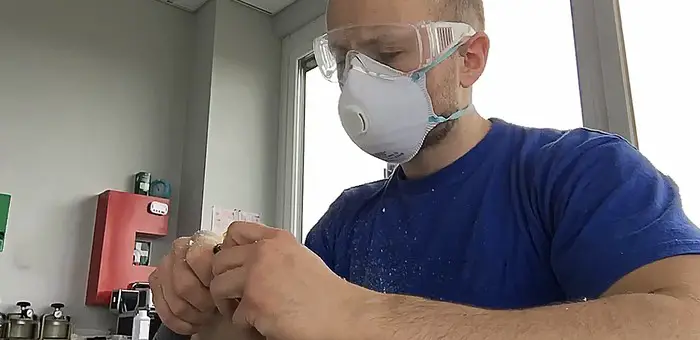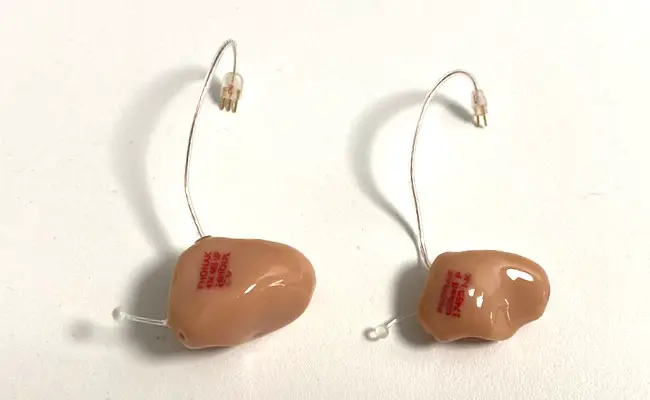Hearing aids today are partly mass-produced and partly customized. This includes on the one hand the shape and the construction of the device but also the adaptation of the software to the hearing loss of the wearer.
Here in this article, you will get an insight into how hearing aids are manufactured. For this purpose, a distinction is made between the production of in-the-ear hearing aids and behind-the-ear hearing aids.
How Are In-The-Ear Hearing Aids Manufactured?
The production of in-the-ear hearing aids classically begins with an individual impression of the auditory canal. This is usually digitized by a 3D scanner and sent to one of the manufacturers. The following data is also added:
- Required amplification/audiogram
- What material should the hearing aid be made of?
- Which technology level should the hearing aid have
- How should the filter system against cerumen be designed
- Does the client want a battery or rechargeable device?
- Does the client want Bluetooth built-in?
- Does the client want directional microphone technology? 2 microphones instead of one?
All of this information in combination with the individual impression is then incorporated into the manufacturing process by the hearing aid manufacturer.
The individual impression of the ear dictates the placement of the individual components during the production of the hearing aid.
The hearing aid manufacturer then uses software to place the components in the best possible way to produce the smallest possible hearing aid. However, it is not only the size that is important here, but also, for example, minimizing the susceptibility to feedback.
Since the shape of each individual in-the-ear hearing aid is different, the components are positioned differently for each hearing aid. This is where individualization takes place in the smallest possible space. Once the optimal position of the components has been determined, the shape of the hearing aid exists in an STL file. This is then produced using a 3D printer.
After the printing of the shape of the hearing aid has been completed, it must still be reworked. During printing, support structures are created which are ground off.
After the mold has been finalized, the electronics must be inserted into the housing, including the plastic bearings to prevent internal feedback and make the hearing aid splash-proof.
The individual shape of the hearing aid is then bonded to the faceplate. The faceplate is the standardized part of the hearing aid that contains the battery or battery door, the chip, and the microphones. After the glue has dried, the faceplate is reworked.

The finished hearing aid is then tested for performance inside a so-called measurement box. After the optimal performance has been verified by a technician, the hearing aid is packed and shipped to the hearing care professional.
Once the hearing care professional receives the hearing aid, he or she will also recheck it and then continue the fitting process on the client. First, the hearing aid is roughly preset using the fitting software. This is called First-Fit. Here the program estimates the gain needed to compensate for the hearing loss. After that, the hearing aid must find the optimal gain.
Percentile analysis or loudness scaling is used for this.
How Are Behind-The-Ear Hearing Aids Made?
Behind-the-ear hearing aids come almost completely assembled from the hearing aid manufacturer’s factory. All electronic components are built into the manufacturer’s design in a standardized manner. The hearing care professional now assembles the correct receiver with a silicone dome or custom earmold. Instead of a receiver that sits directly in the ear, a tube can also connect the hearing aid behind the ear to the earmold that sits in the ear.
If a custom earmold is not chosen, the fitting can be started directly with the acoustician. In many cases, however, a custom fitting is better because it leads to more comparable results.
For example, a silicone dome may be fitted slightly deeper or slightly less deep. However, this also leads to different required amplifications. However, the hearing aid does not detect on its own how deep it has been placed. In order to initiate the individual fitting of an ear mold, an impression of the ear must be taken.
After this has been digitized, the hearing care professional has the choice of ordering a hearing aid directly from the hearing aid manufacturer’s factory or choosing an external laboratory. With an external laboratory, other materials are often available. In comparison, the hearing care professional usually receive the best performing hearing aids directly from the hearing aid manufacturer.

The process for production is very similar. The scan of the ear impression is taken by the laboratory or the manufacturer and the optimal positioning of the electronics or tubing is determined.
Then the data set is printed in with a 3D printer. This is followed by manual post-processing and then the component can be sent to the hearing care professional for assembly.
The audiologist then performs a functional check in the store and can start the fitting process with the hearing aid wearer in the store.
Where Are Hearing Aids Made?
Most of the components for hearing aids are made in Asia. Malaysia, the Philippines, Taiwan, Shenzhen (China), Suzhou (China) this is where a lot of components for hearing aids are manufactured. The assembly oftentimes happens in the target markets in which the hearing aids are sold.
Smaller quantities are also actually made in western markets like Germany.
